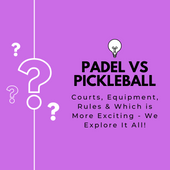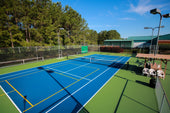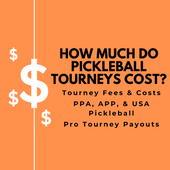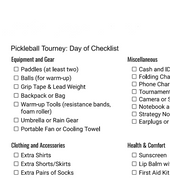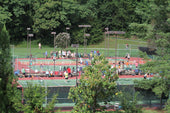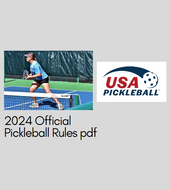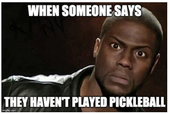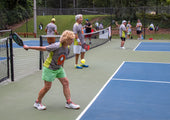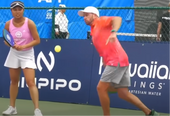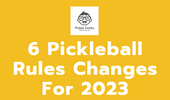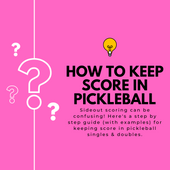If you’re looking to turn the tide of a pickleball game or just mix things up to keep your opponents on their toes, stacking is a strategy that can tilt the court in your team’s favor.
Whether it’s to hide a weak backhand or because you’ve got a southpaw on your side, stacking can make the most of your team’s skills on the pickleball court while giving your opponents one more thing to think about.
Ever wondered if stacking left-handed players has any advantage? Curious about the rules governing stacking? And how do the pros use stacking to get an edge at the highest level of pickleball?
Read on as we’ll answer these questions and more in the awesome videos and article below.
What is Stacking in Pickleball?
Stacking in pickleball is a double strategy where both players on a team position, or “stack”, on the same (left or right) side of the court before the point begins. Stacking can be done by the serving team or the returning team. After the serve or return is struck, both players on the team move to their preferred side of the court to continue the point. Stacking is used to position players on their strongest side of the court.
In this short clip you’ll see the serving team stacking on the far side of the court:
Stacking is typically used when teams have a left-handed player or a player with a weak (or very strong) stroke on one side.
Here’s how stacking works:
- If serving or returning from the even/right side, both players on the team will stack on the even side before one of the players slides to the left side after the serve or return is hit.
- If the serve or return is from the odd/left side, both players on the team will stack on the odd/left side before one of the players slides to the right side after the serve or return is hit.
Is Stacking Legal in Pickleball?
Yes, stacking is legal in pickleball. There are no rules against where players have to stand on the playing area, other than where the server has to serve from.
The technique does not violate any rules or statutes of the game, as there are defined stacking rules for pickleball.
The key with stacking is remembering where you need to be positioned for the next point! With stacking you are moving around and are usually on the wrong side of the court from where you need to be according to pickleball rules, so it’s important to know which side of the court you should be on at all times!
Why do People Stack in Pickleball?
The purpose of stacking in doubles pickleball is to take advantage of a team’s strengths or to have each player on the same side of the court for every point. For example, if a team has a left-handed and a right-handed player, stacking allows each player to be on a side where he or she can hit mostly forehands (which is the stronger side for most players).
Good stacking technique tends to be something a doubles team develops after playing together for a significant amount of time.
This photo shows a doubles team stacking on the return of serve. After the return is hit, the returner will slide to his right side and rush to the kitchen line.

Other reasons teams stack include:
Benefits of Stacking in Pickleball
Stacking gives the benefit of having a player on their stronger side of the court more often than a traditional setup does.
A player with a dominant forehand gets more opportunities to poach forehands or volleys if they’re always on that side of the court.
And as mentioned above, stacking when having a left-hand and right-hand player can give a big advantage to the team. In this set-up, both players will get to hit more forehands, which is usually the stronger side for pickleball players.
Beyond just keeping a forehand to the center, stacking can also maximize a team’s abilities by positioning players on the same side for every point.
Knowing they’ll play on that side of the court, players can practice more on that side, play more points on that side, and should perform better overall since their practice and play has been focused on 1 side of the court.
How to Stack in Pickleball
Stacking on serve is when both players stand on the same side of the court, behind or near the baseline. After the serve, the serving player closest to the middle will slide over to the other side.
In general, a serving team stacks to allow the server to play on the other side of the court.
Stacking on return is slightly more complicated. The player returning serve stands in the traditional position, and the stacked player stands on the same side, out of bounds at the kitchen line.
After the serve is returned, the player that returned the serve then crosses to the other side of the court and their teammate steps into the side where they returned serve. This requires the serve returner to be fast enough to get to the kitchen line on the other side of the court and be in position for the rally!
How do you Stack a Left Handed Player in Pickleball?
In general, you stack a left handed player so that their forehand is always pointing to the middle of the court.
Since most teams with one left handed player don’t have a second, you can end up with both forehands toward the middle of the court - which can be a serious advantage for strong teams (or teams trying to hide a weak side).
You can also stack so both forehands are to the outside, but this wouldn’t make sense for most teams given the forehand strength of most players.
Unless your this guy, who should start reverse stacking:
What is Full Stacking in Pickleball?
Full stacking in pickleball is when a team stacks on every point on both serves and returns.
Risks of Stacking in Pickleball
The big risk in the pickleball stacking strategy is that the stacked team loses track of what side they’re serving from, or who is the designated returning player - leading to a fault.
Since players are moving around and are rarely in their correct position according to pickleball rules, it is easy for players to lose track of where they should be.
In rec. play this isn’t a big deal, but in tournaments being on the wrong side will lead to a fault (either a point for the other team or a lost serve attempt). So it’s important to practice stacking and have a process to verify where you and your teammate should be before every point!
What are the Rules for Stacking in Pickleball?
There aren’t any specific rules for stacking, other than that all stacking players must adhere to the standard of where the server must serve from and the returner must return from.
Stacking in Pickleball: Summary
The purpose of stacking in pickleball is to make the most of your team’s playing strengths, while hopefully also offsetting some of your weaknesses. With stacking you can:
- Put a player with a dominant forehand on the side of the court where he or she can hit the most forehand shots
- Put a player with a weak backhand on the side of the court they hit the fewest backhand shots from
- Make the most of having a left-handed player by switching so both players' forehands are in the center of the court
- Maximize team strengths by putting each player on the same side of the court on every point, where they are most comfortable and accustomed to playing
- Confuse the opposition or as a momentum-changer if your team needs to change things up
Stacking on serve is easier than stacking on receiving, but once you’ve got stacking sorted, it’s a fantastic way to take your pickleball game to the next level!
FAQs: Stacking in Pickleball
Here are some of the most frequently asked questions about stacking in pickleball, besides the classic. “What is stacking in pickleball?!”
Hopefully that has already been answered at this point! Some others are:
How do you Keep Score when Stacking in Pickleball?
Since scoring doesn't change, you continue scoring normally for pickleball doubles.
The important part of scoring if you’re stacking is for both players to remember where they are supposed to be after each point, as it can be quite easy to forget which side of the court you’re supposed to serve or return from!
What is Half Stacking in Pickleball?
Half stacking in pickleball is when a team only stacks while serving or returning serve. In this case, the team is stacking on 1/2 of their total points. Most commonly, a team will half stack by only stacking on serve. A team might do this because stacking while returning is more complicated and the player returning has to move further across the court to get in position for the rally.
Wikipedia actually defines half stacking as stacking on serving and not on receiving- though there’s no reason why a team can’t half stack only on receiving.
What is Three Quarters Stacking in Pickleball?
Three-quarters stacking in pickleball is when a team stacks on every point while serving and on only ½ of the points while returning. In this case the team is stacking on 3/4 of their total points. The main reason a team would ¾ stack is a mobility issue with 1 player, which prevents that player from getting into the correct position quickly after returning serve.
The other reason a team might consider three-quarters stacking is they have a left handed player and a right handed player, and want to keep both players' forehands towards the middle of the court.
How do you Keep Track of Stacking in Pickleball?
By talking with your partner! While you don’t have to be a super-advanced player to start adding stacking into your game, you do need to be able to communicate.
You might decide on a stacking strategy to keep one player on one side of the court the whole match. When you stack, make sure you know who is running and where.
This is where half-stacking for service comes in handy - you only stack when the server is on the non-preferred side of the court, and then only the server runs to the empty (preferred) side.
Keeping track of how your opponents stack, meanwhile, can give you an insight into where their weaknesses are. You might be able to spot a weak backhand, or a slower player, by the way the team stacks and moves.
Is Stacking Good in Pickleball?
Stacking is good in pickleball… But only if you take the time to get good at it! A lot of what makes stacking good when you’re a beginner is whether you or your partner are left handed or have big forehands (or weak backhands!).
Now, that’s not to say two righties can’t get real benefits from stacking.
However, those benefits aren’t going to be as immediate as the ability to suddenly have both players with a forehand shot toward the middle of the court.
It also depends on how honest you can be about what your strengths and weaknesses are.
If your partner has a terrible backhand, stacking can help hide it - but you’re going to be playing a lot of backhand shots, so if yours isn’t any better then stacking won’t help!
If you know you struggle with cross-court movement, then being upfront about it and opting to half stack or three-quarters stack is better than losing points.
Most importantly, stacking is good because it can make playing pickleball more fun. It gives you another skill to master, more options for positioning, and adds different facets to your game.






